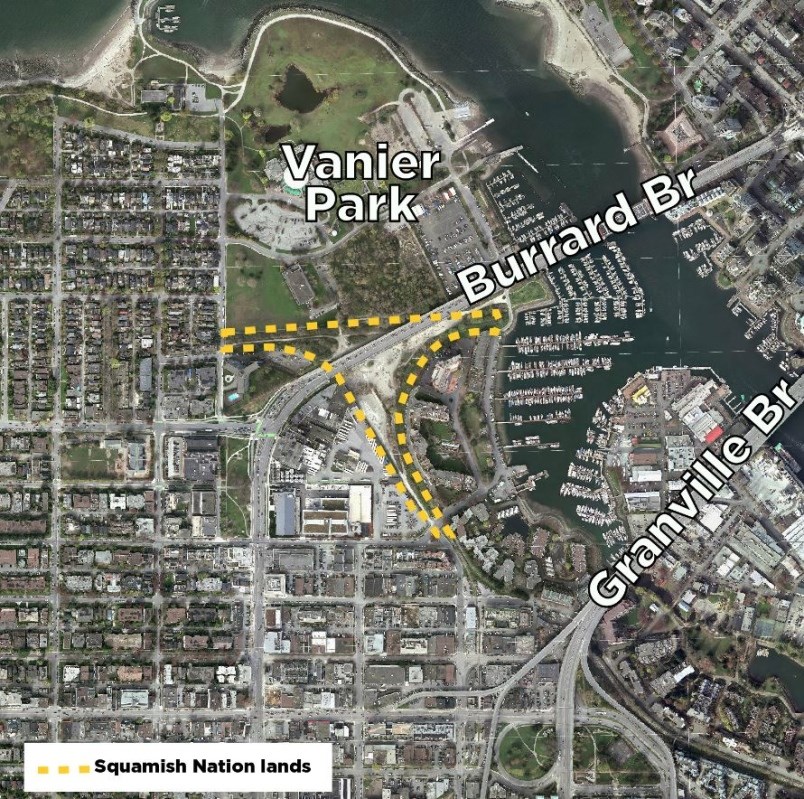Squamish Nation is poised to develop its land at the south end of Burrard Bridge to produce as many as 3,000 residential units, possibly all rental, according to an April 10 Globe and Mail news story.
The unusually shaped, 11-acre parcel is adjacent to Molson Brewery on Burrard Street. In 1913, Squamish band members were forcibly removed from the land and transported to the North Shore and Squamish Valley. Their homes were burned. They reclaimed the land after the B.C. Court of Appeal ruled in 2002 Canadian Pacific should return the land to the band. The province granted CP the land in 1886 and 1902 for the railway.
The possibility of building 3,000 units of housing on the 11-acre site means the development would be dense.
In comparison, the 21-acre Heather Lands, which are being developed by Musqueam Squamish and Tsleil-Waututh Development Corporation and Canada Lands Company, will feature more than 2,300 homes in buildings from three to 24 storeys, retail space, parks, a school site, childcare facility and cultural centre.
The prospect of towers on almost any site in Vancouver typically draws opposition. A pending proposal for a 28-storey building at Broadway and Birch has already sparked complaints about liveability over the long-term, the “downtownification” of the Granville neighbourhood and that shadows from the tower will extend as far as Molson Brewery in Kitsilano.

City of Vancouver manager Sadhu Johnston told the Courier April 10 that staff have only had very preliminary discussions with the Squamish Nation about its plans for their Burrard site at this point. No new meetings are scheduled, but the city doesn’t have jurisdiction to dictate what occurs on Squamish land.
“From the city perspective, we are a city of reconciliation and we recognize that this is another level of government. This is a Nation and it is their jurisdiction to determine what goes there,” Johnston said.
“This is a very significant village site for the Squamish Nation. They were displaced there — physically removed from that site. It wasn’t that long ago that it occurred, so what we really need to recognize is the Nation stepping forward to build rental there is a very important step forward in the journey of reconciliation. I would encourage people to be thinking about this differently than a standard city development.”
While concrete plans haven't been released, Johnston acknowledged that if the plans are for 3,000 housing units, it would be very dense, plus it’s complicated by the “very unique” shape of the site.
Tall buildings, however, have been built near bridges. Johnston pointed to Vancouver House, which is under construction at the north end of Granville Bridge.
“If you look across the water, we’ve done Vancouver House and other projects that are quite creative in the way they integrate with the infrastructure,” he said. “So I think there are creative things that could be done, that we would expect to explore with the Nation.”
Johnston added that Squamish Nation has its own approval process, and it remains to be seen how they engage with the City of Vancouver, which has its own building codes, an Urban Design Panel and Development Permit Board.
“We’ve got our own processes. The Squamish has theirs,” he said. “We will be looking to explore with them what their intentions are for how they plan to refine the project and consult with the community — all those things are to be determined.”
If the development is rental, it's unclear what percentage of homes might be market versus non market.
The City of Vancouver, meanwhile, has ambitious housing targets in its Housing Vancouver strategy, including delivering 72,000 new units by 2027 — 50 per cent of which will be geared towards households earning less than $80,000 annually, while 65 per cent of all new housing would be for renters.
“We certainly know we need more rental but, again, this would really be up to them to determine levels of affordability in types of units and that kind of thing,” Johnston said.
Squamish Nation will have to deal with other levels of government in terms of services to the site. For water and sewer, they must work with Metro Vancouver, while they would deal with the City of Vancouver on issues such as roads, fire and police services.
“I expect the residents there will want to use library and community centres and other city services so we’ll need to engage in discussion with the Nation about those services. It’s something we’ve done already with the Musqueam and we’ve got a very strong partnership with them and a service agreement that maps out what payments are made and what services people get,” Johnston said.
“We would plan to engage with them on that. That would ultimately be a council decision. If there’s a lot of pushback from the proposed project, there would be pressure on council to look hard at that service agreement. I have to imagine that the Nation would be considering that as they’re thinking about the ways to engage with the residents in Vancouver and around the site to have their input on the future of that site.”
Given that there have been discussions about the land over the years, Johnston said he’s not surprised that a dense development is being considered, particularly given the location and the fact the Broadway transit line extension is coming.
“It’s a very walkable, bikeable neighbourhood. It’s close to the two busiest job centres in the province — the downtown and Broadway corridor — so in many ways, it’s a good location for housing,” he said.
The Courier reached out to a Squamish Nation spokesperson. This story will be updated if and when a response is received.
— with files from Mike Howell



